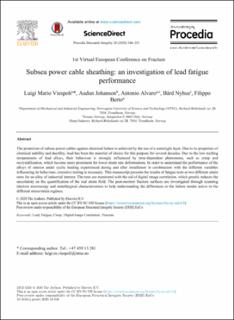| dc.contributor.author | Viespoli, Luigi Mario | |
| dc.contributor.author | Johanson, Audun | |
| dc.contributor.author | Alvaro, Antonio | |
| dc.contributor.author | Nyhus, Bård | |
| dc.contributor.author | Berto, Filippo | |
| dc.date.accessioned | 2022-03-02T08:42:05Z | |
| dc.date.available | 2022-03-02T08:42:05Z | |
| dc.date.created | 2020-10-29T18:39:33Z | |
| dc.date.issued | 2020 | |
| dc.identifier.citation | Procedia Structural Integrity. 2020, 28 344-351. | en_US |
| dc.identifier.issn | 2452-3216 | |
| dc.identifier.uri | https://hdl.handle.net/11250/2982301 | |
| dc.description.abstract | The protection of subsea power cables against electrical failure is achieved by the use of a watertight layer. Due to its properties of chemical stability and ductility, lead has been the material of choice for this purpose for several decades. Due to the low melting temperatures of lead alloys, their behaviour is strongly influenced by time-dependent phenomena, such as creep and recrystallization, which become more prominent for lower strain rate deformations. In order to understand the performance of the alloys of interest under cyclic loading experienced during and after installation in combination with the different variables influencing its behaviour, extensive testing is necessary. This manuscript presents the results of fatigue tests at two different strain rates for an alloy of industrial interest. The tests are monitored with the aid of digital image correlation, which greatly reduces the uncertainty on the quantification of the real strain field. The post-mortem fracture surfaces are investigated through scanning electron microscopy and metallurgical characterization to help understanding the differences in the failure modes active in the different stress/strain regimes. | en_US |
| dc.language.iso | eng | en_US |
| dc.publisher | Elsevier | en_US |
| dc.rights | Attribution-NonCommercial-NoDerivatives 4.0 Internasjonal | * |
| dc.rights.uri | http://creativecommons.org/licenses/by-nc-nd/4.0/deed.no | * |
| dc.subject | Fracture | en_US |
| dc.subject | Digital Image Correlation | en_US |
| dc.subject | Creep | en_US |
| dc.subject | Fatigue | en_US |
| dc.subject | Lead | en_US |
| dc.title | Subsea power cable sheathing: an investigation of lead fatigue performance | en_US |
| dc.type | Peer reviewed | en_US |
| dc.type | Journal article | en_US |
| dc.description.version | publishedVersion | en_US |
| dc.rights.holder | © 2020 The Authors. Published by Elsevier B.V. | en_US |
| dc.source.pagenumber | 344-351 | en_US |
| dc.source.volume | 28 | en_US |
| dc.source.journal | Procedia Structural Integrity | en_US |
| dc.identifier.doi | 10.1016/j.prostr.2020.10.040 | |
| dc.identifier.cristin | 1843376 | |
| cristin.ispublished | true | |
| cristin.fulltext | postprint | |
| cristin.fulltext | original | |
| cristin.qualitycode | 1 | |

